let the objects speak
Nasca - Fringe Fragment
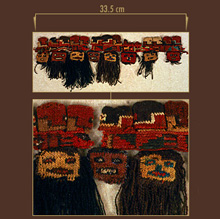
This textile is a fragment of what may have been a fringe element sewn along the armhole or neck slit of a man's tunic. This is the oldest textile in the exhibition, made between A.D. 100 and 300 by the Nasca people of the southern coast of Peru. The human faces represent severed heads. The long black yarn does not indicate a beard, as Andean men lacked such substantial facial hair, but long hair.The heads are stitched to a band with geometric designs. Above the band is a series of paired tabs which represent beans, an Andean staple.
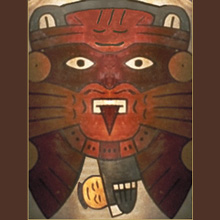
Who
The Nasca were an Andean culture archaeologically represented from 0 - A.D. 700 along the southern coast of Peru. Current archaeological investigations indicate the Nasca did not have a unified central government or a capital city, which are hallmarks of most state-level societies. The Nasca people shared a common cultural tradition, but lived divided into a series of chiefdoms, each with a distinct leader. Scholars surmise that this arrangement brought about a system of organized hostility. It would seem that the capture of enemy energy, in the form of trophy heads, was very important. Nasca art implies a ritual preoccupation with severed heads.
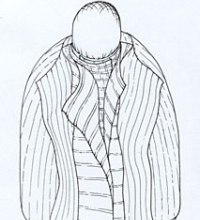
What
This massive ceramic object of the early Nasca style depicts a modest human in a simple men's skirt clutching a baton and a trophy head. He is being preyed upon by a larger, richly adorned personage who appears to be feasting via a long tongue through the victim's neck. The larger personage is interpreted as a long deceased Nasca ancestor. The vessel itself bears a resemblance to mummy bundles, which were meant themselves to represent such mature ancestors.
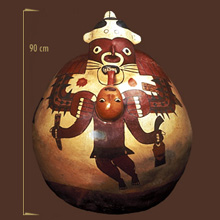
The Nasca possessed a symbol system, which speaks to a belief in the process of transformation upon death where the recently dead, depicted in simple skirts with backward lolling heads, give up their bodily fluids as sustenance to powerful, aged ancestors. This begins a transformation which will change the recently deceased, usually depicted with long hair, into a powerful ancestor itself, replete with adornments, short hair and the characteristics of powerful predatory animals (note the feline whiskers on the pot). The process of the dead giving blood to ancestors, like the dead giving nutrients to the earth, is part of a cycle of death, decay and rebirth.
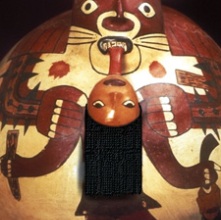
The backbent figure, may encapsulate a link in the mythic cycle of life and death. The imagery of backbent figures transforming in Nasca art is often coupled with images of fertility, commonly of plants or seeds. The woven heads on the Nasca textile are a form of "shorthand" for the long-haired backbent figure. On this piece we also see the fertility imagery in the form of the paired beans along the top. Both our textile piece and our ceramic vessel represent the same system of metaphors used by the Nasca to express their understanding of the afterlife. This becomes clearer when a digital wig is added to the victim on the pot. In ancient times the piece was likely embellished with such a hair-piece.
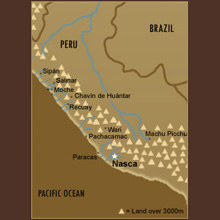
Where
Nasca culture dominated the southern coast of Peru along several different river valleys. Geographically this region receives very little rainfall, and the coastal desert resembles environmental conditions in the African Sahara. Living in one of the driest regions of the world, the Nasca intensified agriculture through irrigation and exploited marine resources. Survival was of greatest concern for Nasca people. Religious belief in sacrifice and trophy head collection speaks of a profound devotion to their gods who they believed controlled the forces of nature.